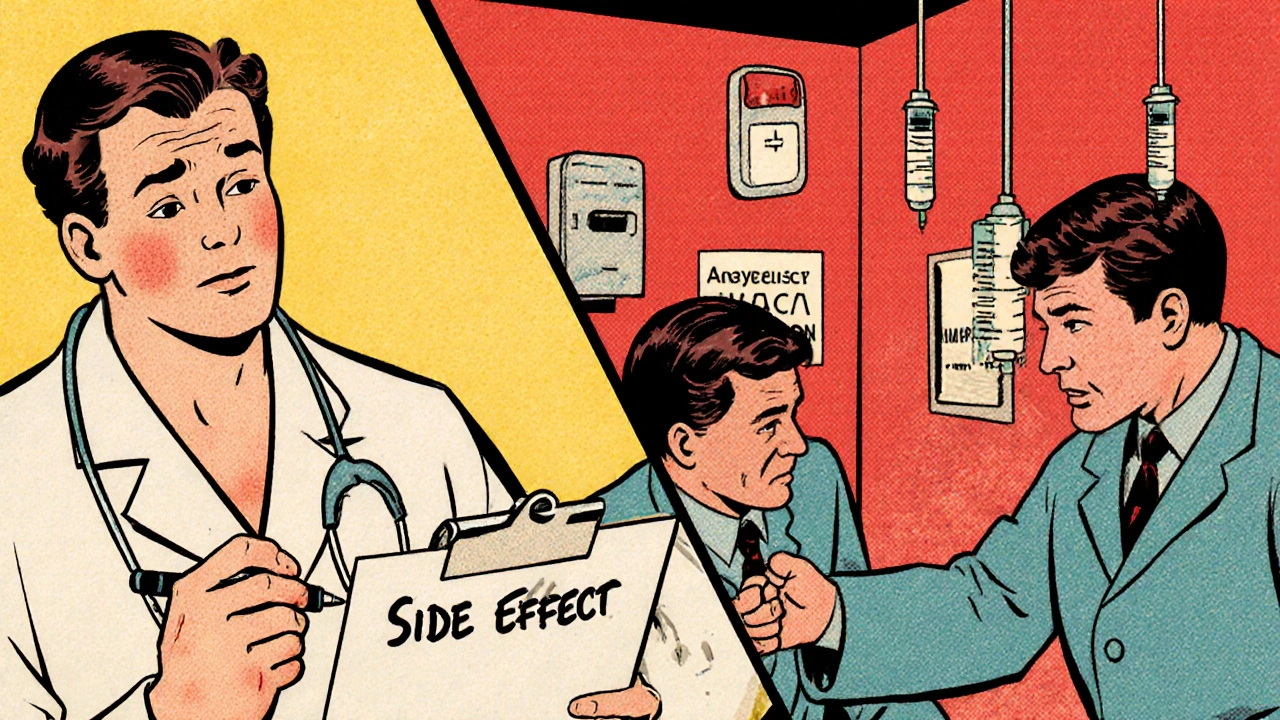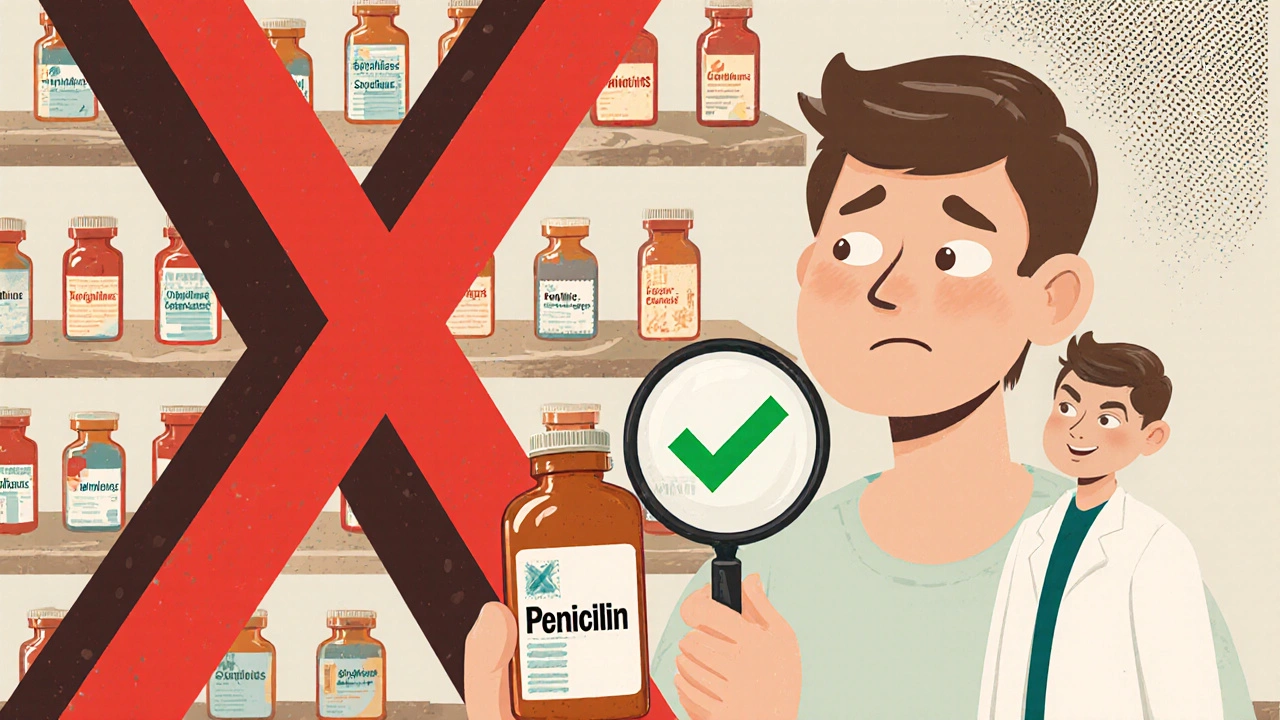When to Avoid a Medication Family After a Severe Drug Reaction
When a drug causes a severe reaction, the instinct is clear: never take anything like it again. But here’s the problem-avoiding an entire medication family might be unnecessary, dangerous, or both. Too often, patients are told to steer clear of all penicillins after a mild rash, or all NSAIDs after stomach bleeding, when the real risk lies with just one specific drug. The result? Delayed care, limited treatment options, and sometimes worse outcomes. So when should you truly avoid a whole class of drugs-and when can you safely try another?
What Counts as a Severe Drug Reaction?
Not every bad reaction means you need to ditch an entire drug family. The FDA defines a severe adverse drug reaction as one that’s life-threatening, requires hospitalization, causes lasting disability, or leads to birth defects. In practice, that means reactions like anaphylaxis, Stevens-Johnson syndrome, toxic epidermal necrolysis, or DRESS syndrome. These aren’t just uncomfortable-they’re deadly. Toxic epidermal necrolysis alone kills 30-50% of people who get it. If you’ve had one of these, avoiding the drug class isn’t just smart-it’s essential.But most reactions aren’t like that. About 80-90% of reported drug reactions are non-allergic. They’re side effects-nausea, dizziness, a rash that fades in a week. These don’t involve your immune system. They’re predictable based on how the drug works in your body. For example, taking ibuprofen and getting an upset stomach doesn’t mean you’re allergic to all NSAIDs. It just means that drug didn’t sit well with you. Switching to a different NSAID, like celecoxib, might be perfectly safe.
When Cross-Reactivity Is Real: The High-Risk Families
Some drug families have well-documented cross-reactivity. If you’ve had a severe reaction to one, you’re at real risk with others in the same group.- Beta-lactam antibiotics (penicillins, cephalosporins, carbapenems): True IgE-mediated penicillin allergy-like anaphylaxis-is rare. Only about 10% of people labeled allergic actually have it. But if you’ve had anaphylaxis or angioedema after penicillin, avoiding all beta-lactams is still recommended until proven otherwise. Cross-reactivity between penicillins and cephalosporins is only 0.5-6.5%, depending on the specific drugs.
- Sulfa antibiotics (Bactrim, Septra): These are linked to severe skin reactions like Stevens-Johnson syndrome. If you had one, avoid all sulfonamide antibiotics. But here’s the catch: sulfa drugs used for diabetes (like glimepiride) or diuretics (like furosemide) are chemically different. They rarely cause cross-reactions. Yet many patients are wrongly told to avoid them all.
- NSAIDs: If you have aspirin-exacerbated respiratory disease-wheezing, nasal polyps, asthma attacks after taking aspirin or ibuprofen-then avoiding all traditional NSAIDs is necessary. About 70% of these patients react to multiple drugs in this group. But COX-2 inhibitors like celecoxib are often tolerated.
- Anticonvulsants (carbamazepine, phenytoin, lamotrigine): These are among the top causes of life-threatening skin reactions. If you had DRESS or SJS from one, avoid the entire class. Genetic testing for HLA-B*15:02 can help identify risk before even starting carbamazepine.
- Allopurinol: Used for gout, this drug causes DRESS and TEN in about 1 in 1,000 people. If you’ve had a severe reaction, never take it again. Genetic testing for HLA-B*58:01 is now standard before prescribing it in high-risk populations.
When Avoiding the Whole Family Is a Mistake
Many patients are wrongly labeled allergic because of a mild or non-immune reaction. This leads to unnecessary avoidance-and worse, the use of broader-spectrum antibiotics that increase resistance and side effects.Take maculopapular rashes from amoxicillin. They’re common-happening in 5-10% of kids and adults-but they’re almost never true allergies. They’re often viral in origin, not drug-related. Yet patients are told to avoid all penicillins for life. Studies show 95% of people with this label can safely take penicillin after proper testing. One patient in Texas, labeled allergic for 20 years after a childhood rash, got skin testing and ended up taking amoxicillin for a sinus infection without a problem.
Same goes for statins. If you got muscle pain with atorvastatin, you might not react to rosuvastatin or simvastatin. Cross-reactivity is only 10-15%. Many patients give up on cholesterol control altogether because they assume all statins are the same. They’re not.
And then there’s the sulfa confusion. After a Stevens-Johnson syndrome reaction to Bactrim, patients are told to avoid all sulfa drugs-even ones used for glaucoma or diuretics. But those drugs don’t share the same chemical structure that triggers immune reactions. Avoiding them unnecessarily limits treatment options for unrelated conditions like high blood pressure or eye pressure.

How Doctors Decide What to Avoid
There’s a standard process for figuring out if you need to avoid a whole class of drugs. It’s not guesswork.- Characterize the reaction: When did it happen? What were the symptoms? Did you need epinephrine? Were you hospitalized? A rash that appeared a week after starting a drug is unlikely to be IgE-mediated. A reaction within 30 minutes with swelling and trouble breathing is.
- Use standardized terms: Don’t just write “allergic to penicillin.” Use SNOMED CT codes like “Anaphylactic reaction to penicillin” or “Non-allergic rash to amoxicillin.” This helps other doctors understand the real risk.
- Assess cross-reactivity risk: Tools like the DELPHI instrument help predict whether a reaction to one drug means danger with another. It’s 89% accurate.
- Consider alternatives: If you can’t take a drug in a class, is there another class that works? For example, if you can’t take a beta-lactam, azithromycin or doxycycline might be safe options.
- Test if needed: Drug challenges under supervision can prove you’re not allergic. For penicillin, a graded oral challenge has a 70-85% success rate in low-risk patients. Skin testing with penicillin metabolites is now standard in major hospitals.
The Cost of Over-Avoidance
Avoiding a whole drug class when you don’t need to has real consequences. A 2022 survey by the Asthma and Allergy Foundation of America found that 42% of patients with drug allergy labels faced delays in getting the right treatment. On average, they waited 3.2 extra days for antibiotics. That’s time lost, complications that could’ve been avoided, and sometimes hospital stays.Doctors also end up prescribing broader antibiotics-like vancomycin or fluoroquinolones-when they think a patient is allergic to penicillin. These drugs are more expensive, more likely to cause C. diff infections, and contribute to antibiotic resistance. One study found that patients labeled penicillin-allergic had a 69% higher risk of getting a C. diff infection.
And then there’s the emotional toll. Patients live in fear. They avoid emergency rooms. They skip dental work. They refuse surgery because they’re told they can’t get anesthesia with certain drugs. All because of a mislabeling that happened years ago.
What You Can Do
If you’ve had a severe reaction, don’t panic-but don’t accept blanket avoidance without questions.- Ask: Was this a true allergy or a side effect?
- Ask: Can I be tested to confirm?
- Ask: Are there safer alternatives within the same class?
- Ask: Has my record been updated with specific details?
Many academic hospitals now have drug allergy clinics. They offer skin testing, oral challenges, and de-labeling programs. If you’re told you’re allergic to a whole class, ask if you can be referred. You might be surprised to learn you can safely take the drug again.
And if you’ve been labeled allergic for years, get re-evaluated. The American College of Allergy, Asthma, and Immunology recommends retesting all patients with a penicillin allergy label-even if it happened decades ago. Most will find they’re not allergic at all.
What’s Changing in Drug Safety
The field is moving fast. In 2022, the FDA approved the first component-resolved diagnostic test for drug allergies, improving accuracy from 60% to 89%. Genetic testing for HLA-B*57:01 before prescribing abacavir (an HIV drug) has nearly eliminated fatal reactions. AI tools like IBM Watson for Drug Safety are now helping hospitals reduce unnecessary avoidance by 41%.Hospitals are also improving their electronic health records. The NIH’s Preventing Overrides of Severe Drug Allergy Alerts Initiative cut inappropriate overrides by 37% by forcing doctors to justify why they’re ignoring an allergy alert. That’s huge. It means fewer mistakes.
And the push for de-labeling is growing. As of 2023, 87% of academic medical centers have formal penicillin allergy assessment programs. That number was under 20% just five years ago.
Bottom Line
Severe drug reactions demand respect. But they don’t always mean lifelong avoidance of entire drug families. The key is knowing the difference between a true immune reaction and a side effect. If you’ve had anaphylaxis, SJS, or TEN-avoid the class. But if you had a mild rash, stomach upset, or dizziness? Get evaluated. You might be able to take the drug again. Or at least, a safer version of it.Don’t let an old label limit your care. Ask questions. Demand testing. And if your doctor says no, ask for a referral to a drug allergy specialist. Your next treatment could depend on it.
Do all drug allergies mean I have to avoid the whole family?
No. Only immune-mediated reactions like anaphylaxis, Stevens-Johnson syndrome, or DRESS require avoiding an entire class. Most reactions-like rashes or stomach upset-are side effects, not allergies. You may still be able to take other drugs in the same family. Testing can confirm.
Can I outgrow a drug allergy?
Yes. Many people labeled allergic to penicillin in childhood lose their sensitivity over time. Studies show that 80% of people with a penicillin allergy label aren’t allergic after 10 years. Testing can confirm whether you’re still at risk.
Are skin tests for drug allergies reliable?
For penicillin, yes. Skin testing with penicillin metabolites is 95% accurate at ruling out IgE-mediated allergy. For other drugs, testing is less standardized but still useful. Blood tests and oral challenges are also used when skin testing isn’t available.
What if I need a drug I’m allergic to?
In life-threatening situations-like severe infection with no alternatives-doctors may use desensitization. This involves giving tiny, increasing doses under close supervision. It’s temporary but can save lives. It’s not for mild reactions or non-emergencies.
Can I be tested for sulfa allergies?
There’s no reliable skin or blood test for sulfa antibiotics. Diagnosis is based on reaction history. If you had a severe skin reaction like SJS after Bactrim, avoid all sulfonamide antibiotics. But non-antibiotic sulfa drugs (like diuretics) are usually safe. Always check with an allergist.
How do I update my medical records after testing?
Ask your allergist to send a letter to your primary care doctor and any specialists you see. Make sure the allergy is changed from "allergic" to "not allergic" or "no true allergy confirmed." Also request that your EHR be updated with specific details: the drug, the reaction, the test result, and the date of evaluation.







9 Comments
Scott Macfadyen
November 18, 2025 at 04:03
Just had my third antibiotic course in two years because they wouldn't give me amoxicillin even though I got a rash at 7 that vanished in three days. Turns out I'm not allergic. My doctor just copied the note from my old file. No testing. No questions. Just fear.
Now I'm on vancomycin. Cost? $2,000. Side effects? Diarrhea for a week. And I still had to go back for a second round because the first one didn't work.
We're doing more harm than good by over-labeling people. It's not medicine. It's medical superstition.
Chloe Sevigny
November 19, 2025 at 10:54
The systemic failure here is not merely clinical-it is epistemological. We have conflated correlation with causation in pharmacovigilance, then codified that error into electronic health record ontologies, thereby entrenching iatrogenic harm through algorithmic inertia.
SNOMED CT is a necessary but insufficient intervention when the underlying paradigm remains anchored in binary classification: allergic or not. The reality is probabilistic, context-dependent, and temporally dynamic.
And yet, we persist in treating drug reactions as categorical absolutes, ignoring the ontogeny of immune memory and the heterogeneity of haptens.
Until we integrate pharmacogenomics and longitudinal symptom mapping into routine clinical workflow, we are not practicing medicine-we are performing bureaucratic triage dressed in white coats.
Denise Cauchon
November 20, 2025 at 20:10
Canada’s healthcare system is full of cowards. Doctors don’t want to be sued, so they tell you to avoid everything. Even if you had a tiny rash from penicillin at age 5, you’re labeled allergic for life. No one wants to take responsibility.
Meanwhile, people in the US are getting tested, getting de-labeled, and saving millions in healthcare costs. But here? We’d rather you suffer with a $500 generic antibiotic that gives you C. diff than risk a lawsuit over a 20-year-old rash.
It’s not medicine. It’s cowardice with a stethoscope.
And don’t even get me started on how we treat sulfa drugs. My aunt couldn’t get her diuretic because some idiot wrote "sulfa allergy" in her chart. She’s got heart failure and now she’s on a drug that makes her dizzy. All because of a 1998 skin reaction to Bactrim.
Someone needs to fix this. Or at least stop pretending we’re smart.
Andrea Johnston
November 20, 2025 at 23:35
You think you’re being careful by avoiding everything? You’re being reckless.
My cousin was told she couldn’t take any NSAIDs after a stomach upset from ibuprofen. So she took Tylenol for years. Then she developed kidney damage from chronic acetaminophen use.
She could’ve taken celecoxib. Safe. Effective. No issues. But no one told her. No one even asked.
And now she’s on dialysis.
Stop treating every side effect like a death sentence. You’re not protecting people. You’re killing them slowly with ignorance.
Victoria Malloy
November 21, 2025 at 13:39
This post gave me hope. I’ve been scared to take any painkillers since I got a rash after taking naproxen 15 years ago. I never thought to ask if it was an allergy or just a side effect. I just assumed I had to live without relief.
Now I’m going to ask my doctor about testing. I don’t want to keep suffering just because someone wrote "allergic" in a chart once.
Thank you for explaining this so clearly.
Alex Czartoryski
November 22, 2025 at 00:27
Oh here we go. Another ‘science says’ post from someone who thinks reading a medical article makes them an expert.
Let me guess-you also think you can diagnose your own allergies with Google and a skin prick test you bought off Amazon?
Real talk: if you’ve had anaphylaxis, don’t be an idiot. Don’t test it yourself. But if you got a little rash and didn’t even go to the hospital? Maybe you’re just sensitive. Not allergic.
But don’t go telling people to just ‘try it again’ like it’s a game of Russian roulette. Some reactions are silent killers.
And yes, I’ve been there. My brother died from a misdiagnosed drug reaction. So don’t preach to me about ‘overavoidance.’
Balance. Not bravado.
Gizela Cardoso
November 23, 2025 at 06:50
I work in a hospital pharmacy. We see this every day.
Patients come in with ‘penicillin allergy’ on their chart and we have to use clindamycin or azithromycin instead. Both are broader spectrum. Both cost more. Both increase resistance.
We just had a 78-year-old come in with a UTI. Had a rash from amoxicillin in 1987. We did a graded challenge. She tolerated it fine. No reaction.
She cried. Said she hadn’t been able to take antibiotics for her infections since her daughter was born.
That’s the real cost. Not money. Time. Fear. Lost years.
Testing isn’t risky. Not testing is.
Jeff Hakojarvi
November 23, 2025 at 23:31
just want to say thank you for this. i had a rash after amoxicillin when i was 10 and was told to never take it again. 20 years later, i got tested at a clinic in toronto and turns out i was never allergic. they gave me a little dose and i was fine.
now i’m telling everyone i know to get checked. so many people are living with unnecessary fear.
also-please, doctors, update your notes. my ehr still says "penicillin allergy" even though the allergist sent a letter. it’s frustrating.
you guys are doing good work. keep it up.
Timothy Uchechukwu
November 25, 2025 at 00:05
you westerners always overthink everything
in nigeria we just take the medicine or dont
if you get sick you get sick
if you die you die
no testing no labs no fancy words
we dont have time for your fear
my uncle took penicillin after a rash and lived
your system is broken because you are scared of everything
stop making medicine a religion
just give the pill
and if it kills you well
at least you tried
not like you sitting in your lab with your charts and your SNOMED codes
real people live real lives
stop overcomplicating death